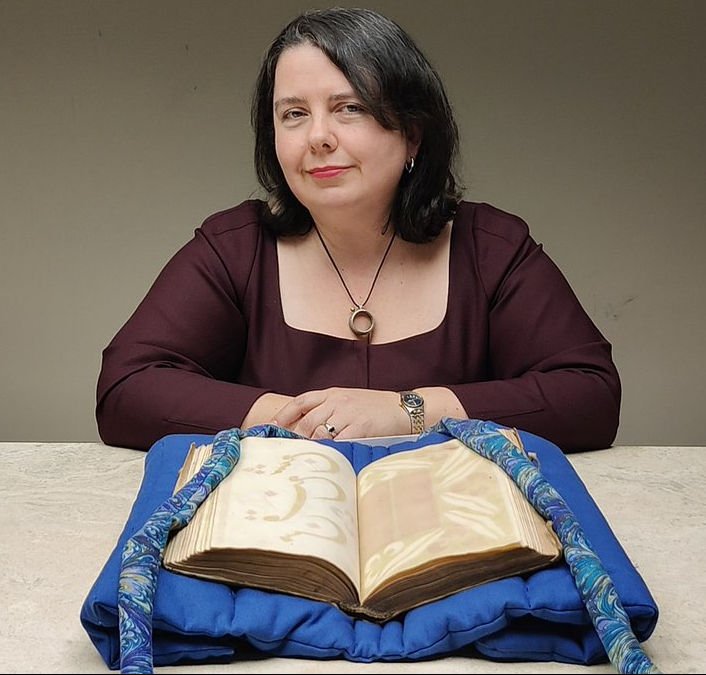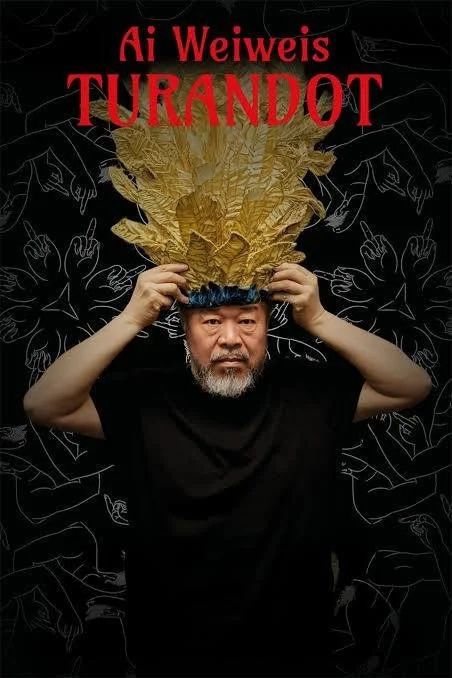Suzanne Karr Schmidt is the George Amos Poole III Curator of Rare Books and Manuscripts at the Newberry Library. Previously, she served as Assistant Curator in the Department of Prints and Drawings at the Art Institute of Chicago (2013–2016), following fellowships there from 2008. Her curatorial work blends material culture, print history, and public engagement. A specialist in interactive Renaissance printmaking, she is the author of Altered and Adorned: Using Renaissance Prints in Daily Life and Interactive and Sculptural Printmaking in the Renaissance. She holds degrees from Brown and Yale, a Rare Book School certificate, and has also worked in the antiquarian book trade. She co-leads the Kress-funded Newberry Seminar in European Art.
When did you first fall in love with art? For you, what is the importance of the arts? I grew up in Washington D.C., with the National Gallery as my "local" museum, and so I have always felt that art should be for everyone!
What does your typical day look like at the Newberry? What kinds of activities make for an especially fulfilling day for you as a curator of rare books and manuscripts? The best days at the Newberry are ones working primarily with objects (installing exhibitions, leading collection presentations for groups), though I also spend a fair amount of time researching potential acquisitions or overlooked collection items. I'm always looking for ways to bring our collections to the public, especially when something new arrives.
Your upcoming exhibition Printing on Fabric delves into rarely explored intersections of print and textile. What drew you to this subject, and what kind of stories are you hoping this show will bring to light? My next Newberry exhibition (December 10, 2026 to April 3, 2027) brings together textiles and prints as never before! The show, featuring brand new research about the luxury art of Printing on Fabric before 1800, ties together political portraiture (on silk or on cotton hankies), tactile religious relics (such as small Shroud of Turin replicas), and over-the-top statement prints celebrating important life events like weddings and graduations. While many museums and libraries have these types of items, which could also have been printed on paper, they have yet to see them in their gloriously shimmering, broader context.
Among the many remarkable objects in your care, is there one recent acquisition or discovery that has captured your imagination? My current favorite artwork is a recent Newberry acquisition, an enormous 1746 woodblock, engraving, and letterpress broadside printed on cream satin and embroidered for an impressive PhD thesis ceremony. The publisher, Manuela Cerezo, was a powerhouse businesswoman, owning presses in Puebla and in Mexico City. It will be a focal point in the Printing on Fabric exhibition and its catalogue, and was discussed in the first segment of our recent Getty Paper Project workshop keynote session:
If you could spend time with any artist from the past, who would you be most curious to observe in their process?
The German Renaissance rockstar, painter and printmaker Albrecht Dürer!
Chicago has an incredible cultural landscape. Are there any unique events or traditions at the Newberry that reflect how the city informs your work? A great thing about living in Chicago is that we have wonderful museums and libraries, as well as a great food culture. The Newberry mixes the two annually by hosting the Edible Book Festival (an international event) in which books become works of edible art, often to delicious and humorous effect!
The main characteristic of a good curator is contagious curiosity.
What is your favourite epoch?
The long Renaissance (15th-17th c.), but I dabble in the 18th c. as well.
Growing up near major national institutions in D.C. and later working in museums and rare book libraries, how have those environments shaped your curatorial approach? Growing up in Washington D.C. meant that I could be a summer intern at the Smithsonian and the National Gallery while living at home. As a result, I strongly believe that all cultural institutions should offer free admission. I had always wanted to work in museums, and my doctoral research on the Renaissance pop-up book opened doors to rare book libraries as well.
Your exhibitions often draw connections across media—like prints and sculpture, or devotional objects and pop-up books. Can you share a time when this kind of interdisciplinary thinking challenged or surprised you?
As a fellow and later an assistant curator in the department of prints and drawings at the Art Institute of Chicago from 2008 to 2016, I learned the importance of contextualizing artworks on paper with other objects and the benefits of interdepartmental collaboration. Simply showing framed pieces of paper, while beautiful, does not always tell the full story. My first exhibition there, 2011's Altered and Adorned: Using Renaissance Prints in Daily Life gave me the excuse to get to know the collections throughout the museum. The central item was a ca. 1490s colored print pasted into a carrying case or "messenger box," begging the question of where else prints had been applied and lost in the past. I exhibited gilded armor next to a print of a knight on vellum with gold details, an early printed Japanese sutra and the pagoda it was housed in next to European devotional prints, textiles next to printed embroidery patterns, and books with prints pasted inside near print albums, among other items.
A 2015 collaboration with the Art Institute department of Ancient Art, Dionysos Unmasked, became a dialogue between marbles unearthed in Rome during the Renaissance and the famous prints inspired directly by them. In the case of Antonio Pollaiuolo's Battle of the Naked Men, the print may never have been previously exhibited with the sculpture, as it remains in private hands, on loan to the museum.
My first Newberry exhibition, Renaissance Invention: Stradanus's Nova Reperta, was also a collaboration, with Lia Markey, the director of our Center for Renaissance Studies. The show focused on a series of Italian prints that claimed Europe had invented many of the technologies that had created progress throughout history, including gunpowder (allowing us to borrow a miniature cannon) although this was entirely inaccurate. Sadly, as the show was slated to go on view in 2020, we had to cancel most related programming due to the pandemic, and pivoted to online events. This was also the first year that the Newberry documented its exhibitions in video walkthroughs, and happily we have been able to increase our outreach by continuing this practice.
When you collaborated with Chicago artists for the Pop-Up Books Through the Ages exhibition, what did that process teach you about working across fields and formats?
For our blockbuster 2023 Pop-Up Books through the Ages exhibition at the Newberry, we commissioned a diy pop-up Newberry library kit from two fantastic Chicago artists, Hannah Batsel, who did the illustration, and Shawn Sheehy, who did the paper engineering. It was an ongoing discussion, and resulted in a playful, didactic object based closely on the library itself. The resulting miniature, pop-up library was laser cut, and even includes a rotating wheel with images of many Newberry items. It even demonstrates the architectural peculiarity of the 1893 Newberry building, which was never completely finished, resulting in dramatically uneven arches on two sides. We went through several designs for an eventual edition of 16,000 copies, which were given away gratis at the exhibition, and have now been distributed to all fifty states, many countries, and all the continents, including Antarctica!
One unexpected outcome of the collaboration was my decision to take on the volunteer directorship of the Movable Book Society, an international organization for makers, collectors, and scholars of pop-up books, and it too continues to be a rich collaboration.
Who do you feel helped shape your approach to curation? What advice would you give to aspiring museum professionals or artists entering the field today?
My museum and library colleagues over the years have been nothing but generous with their time and expertise. Martha Tedeschi, who until recently directed the Harvard Art Museums, following a long career at the Art Institute, has been a particular model for leadership in the print field, as well as a champion of work-life balance. Unfortunately, new museum professionals may not find the jobs they might hope for initially, but I would recommend as much creativity as possible in the types of experience they pursue; smaller institutions, as well as libraries and museums with different focuses all have much to teach, and often fewer hands for the work. As curators are by necessity generalists, the wider the range of their interests, the better suited they will be when the right position opens up. As long as they can demonstrate without a doubt that collections are central to their interests, rather than serving as a convenient stepping stone to an academic position, they will eventually find their place.
AI is changing everything. How do you see the role of traditional, handmade works evolving? And how does the Newberry’s approach to hands-on learning fit into that picture?
AI is not part of my curatorial practice. Human creativity over the centuries have been far more complex and curious than AI regurgitations will ever become. The Newberry prioritizes hands-on learning, and we take pride in welcoming anyone age 14 (or in 9th grade) and up to register (for free) to become a reader. This means you can request and in fact touch anything in the millions of prints, drawings, maps, books, and manuscripts in our collection. Our exhibitions, fellowships, and public programs bring writers, artists, and scholars together to look at the originals as well, many of which are uniquely preserved by the Newberry. We are also actively digitizing our collection materials for those who cannot visit in person... yet.



















































































